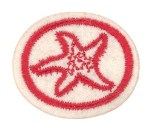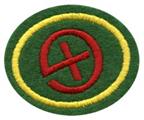- Be able to identify at least one example of fifteen of the following seashore animals:
- Tunicate (sea squirt)
- Anemone (sea flower)
- Chitin
- Hermit crab
- Brittle star or serpent star
- Sea urchin
- Sea cucumber
- Bryozoa colony (moss animal)
- Barnacle
- Common starfish
- Mussel or clamworm
- Jellyfish
- Limpet
- Tube worm
- Oyster
- Amphipod (sand flea)
- Sponge
- Sand dollar
- Coral
- Ghost crab
- Make a collection of the following seashore animals:
- Three kinds of crabs
- One kind of starfish
- Any other five animals listed in requirement No. 1
Hard-bodied animals, such as crabs, starfish, and chitons, may be killed in a 5% solution of formaldehyde or a 70% solution of alcohol, and then dried by a fire. The sun will cause the color to fade. Soft- bodied animals must be kept in a 3% solution of formaldehyde or a 70% solution of alcohol. If commercial formalin is used in place of formaldehyde, the above percentage figures should be doubled.
- Describe the following processes:
- The swimming action of a jellyfish
- The method of an anemone capturing food
- The running of a crab
- How does a starfish digest a clam or oyster when it has such a small mouth opening?
- Name four low-tide animals and two high-tide animals.
- Answer the following questions on relationships:
- What relationship do crabs and barnacles have to insects?
- What relationship does the sea squirt have to man?
- Name a common land dweller that is related to the clamworm.
- The octopus belongs to the phylum Mollusca. Which two animals listed in No. 1 are related to the octopus?
- Give an oral report on two of the following activities:
- Visit a seashore at night and by means of a flashlight observe the activity of animals on shore and in the water. Notice the thousands of plants and animals visible when the beam of light is directed into the water. These minute organisms are called plankton.
- Tow a fine-mesh cloth or regular plankton net through the water and observe through a microscope the many tiny animals and plants that are collected.
- Select three items under No. 1 that are important economically. Explain why they are important.





